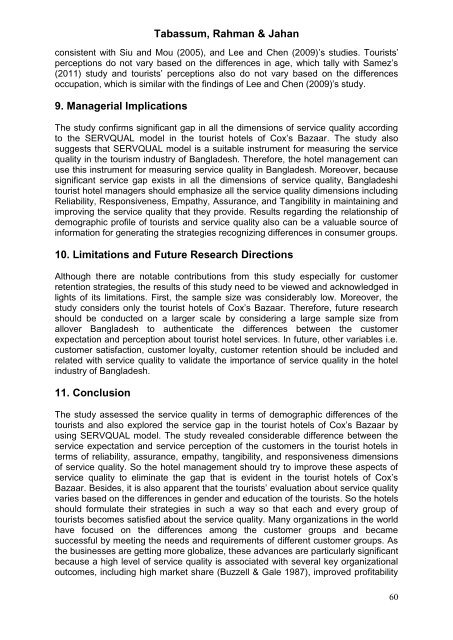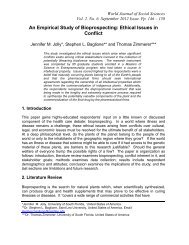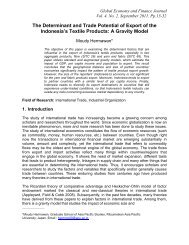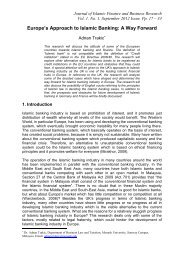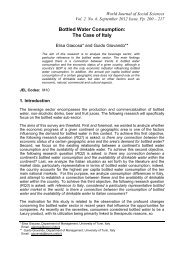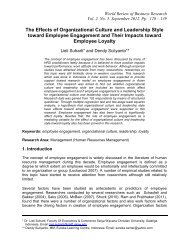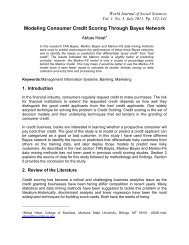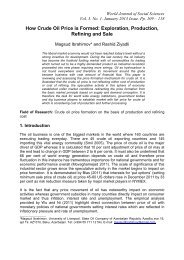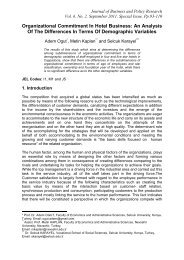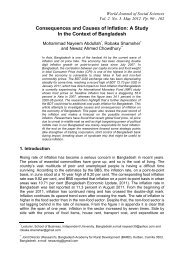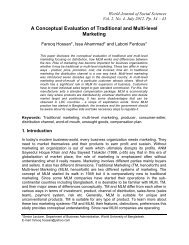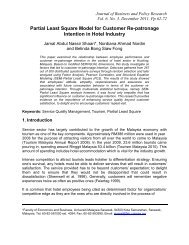Assessment of Service Quality in Tourist Hotels of ... - Wbiaus.org
Assessment of Service Quality in Tourist Hotels of ... - Wbiaus.org
Assessment of Service Quality in Tourist Hotels of ... - Wbiaus.org
You also want an ePaper? Increase the reach of your titles
YUMPU automatically turns print PDFs into web optimized ePapers that Google loves.
Tabassum, Rahman & Jahanconsistent with Siu and Mou (2005), and Lee and Chen (2009)’s studies. <strong>Tourist</strong>s’perceptions do not vary based on the differences <strong>in</strong> age, which tally with Samez’s(2011) study and tourists’ perceptions also do not vary based on the differencesoccupation, which is similar with the f<strong>in</strong>d<strong>in</strong>gs <strong>of</strong> Lee and Chen (2009)’s study.9. Managerial ImplicationsThe study confirms significant gap <strong>in</strong> all the dimensions <strong>of</strong> service quality accord<strong>in</strong>gto the SERVQUAL model <strong>in</strong> the tourist hotels <strong>of</strong> Cox’s Bazaar. The study alsosuggests that SERVQUAL model is a suitable <strong>in</strong>strument for measur<strong>in</strong>g the servicequality <strong>in</strong> the tourism <strong>in</strong>dustry <strong>of</strong> Bangladesh. Therefore, the hotel management canuse this <strong>in</strong>strument for measur<strong>in</strong>g service quality <strong>in</strong> Bangladesh. Moreover, becausesignificant service gap exists <strong>in</strong> all the dimensions <strong>of</strong> service quality, Bangladeshitourist hotel managers should emphasize all the service quality dimensions <strong>in</strong>clud<strong>in</strong>gReliability, Responsiveness, Empathy, Assurance, and Tangibility <strong>in</strong> ma<strong>in</strong>ta<strong>in</strong><strong>in</strong>g andimprov<strong>in</strong>g the service quality that they provide. Results regard<strong>in</strong>g the relationship <strong>of</strong>demographic pr<strong>of</strong>ile <strong>of</strong> tourists and service quality also can be a valuable source <strong>of</strong><strong>in</strong>formation for generat<strong>in</strong>g the strategies recogniz<strong>in</strong>g differences <strong>in</strong> consumer groups.10. Limitations and Future Research DirectionsAlthough there are notable contributions from this study especially for customerretention strategies, the results <strong>of</strong> this study need to be viewed and acknowledged <strong>in</strong>lights <strong>of</strong> its limitations. First, the sample size was considerably low. Moreover, thestudy considers only the tourist hotels <strong>of</strong> Cox’s Bazaar. Therefore, future researchshould be conducted on a larger scale by consider<strong>in</strong>g a large sample size fromallover Bangladesh to authenticate the differences between the customerexpectation and perception about tourist hotel services. In future, other variables i.e.customer satisfaction, customer loyalty, customer retention should be <strong>in</strong>cluded andrelated with service quality to validate the importance <strong>of</strong> service quality <strong>in</strong> the hotel<strong>in</strong>dustry <strong>of</strong> Bangladesh.11. ConclusionThe study assessed the service quality <strong>in</strong> terms <strong>of</strong> demographic differences <strong>of</strong> thetourists and also explored the service gap <strong>in</strong> the tourist hotels <strong>of</strong> Cox’s Bazaar byus<strong>in</strong>g SERVQUAL model. The study revealed considerable difference between theservice expectation and service perception <strong>of</strong> the customers <strong>in</strong> the tourist hotels <strong>in</strong>terms <strong>of</strong> reliability, assurance, empathy, tangibility, and responsiveness dimensions<strong>of</strong> service quality. So the hotel management should try to improve these aspects <strong>of</strong>service quality to elim<strong>in</strong>ate the gap that is evident <strong>in</strong> the tourist hotels <strong>of</strong> Cox’sBazaar. Besides, it is also apparent that the tourists’ evaluation about service qualityvaries based on the differences <strong>in</strong> gender and education <strong>of</strong> the tourists. So the hotelsshould formulate their strategies <strong>in</strong> such a way so that each and every group <strong>of</strong>tourists becomes satisfied about the service quality. Many <strong>org</strong>anizations <strong>in</strong> the worldhave focused on the differences among the customer groups and becamesuccessful by meet<strong>in</strong>g the needs and requirements <strong>of</strong> different customer groups. Asthe bus<strong>in</strong>esses are gett<strong>in</strong>g more globalize, these advances are particularly significantbecause a high level <strong>of</strong> service quality is associated with several key <strong>org</strong>anizationaloutcomes, <strong>in</strong>clud<strong>in</strong>g high market share (Buzzell & Gale 1987), improved pr<strong>of</strong>itability60


